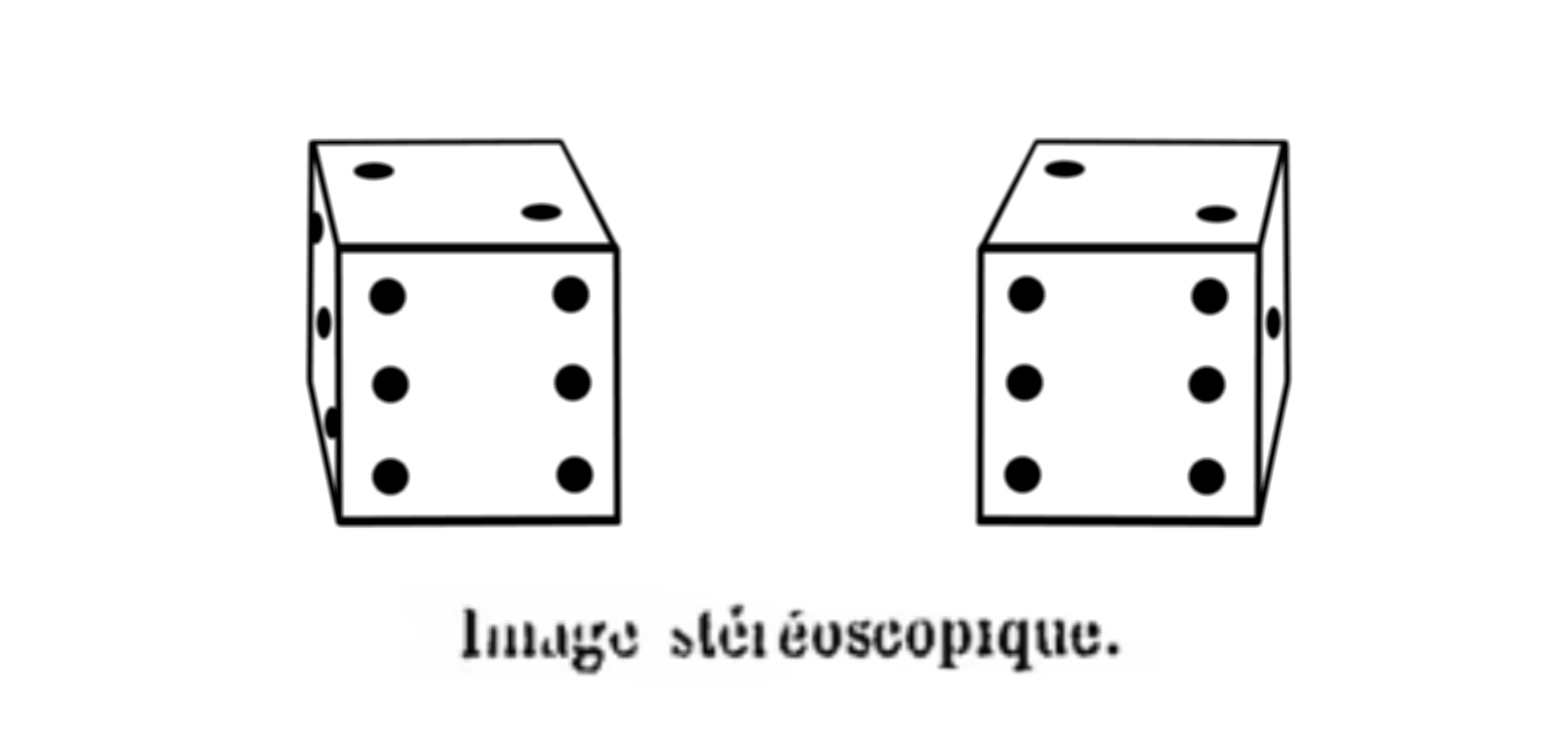
Here I will explain why I made a replica of a Wheatstone stereoscope, how I designed and built it and what I learned from it.
 |
Figure 1 – Binocular Disparity |
Wheatstone had guessed that the image we see with our right eye was different from the image we see from our left since each eye views objects from a slightly different perspective (figure 1) and that that had something to do with how we percieved depth and volume. We call this binocular disparity.
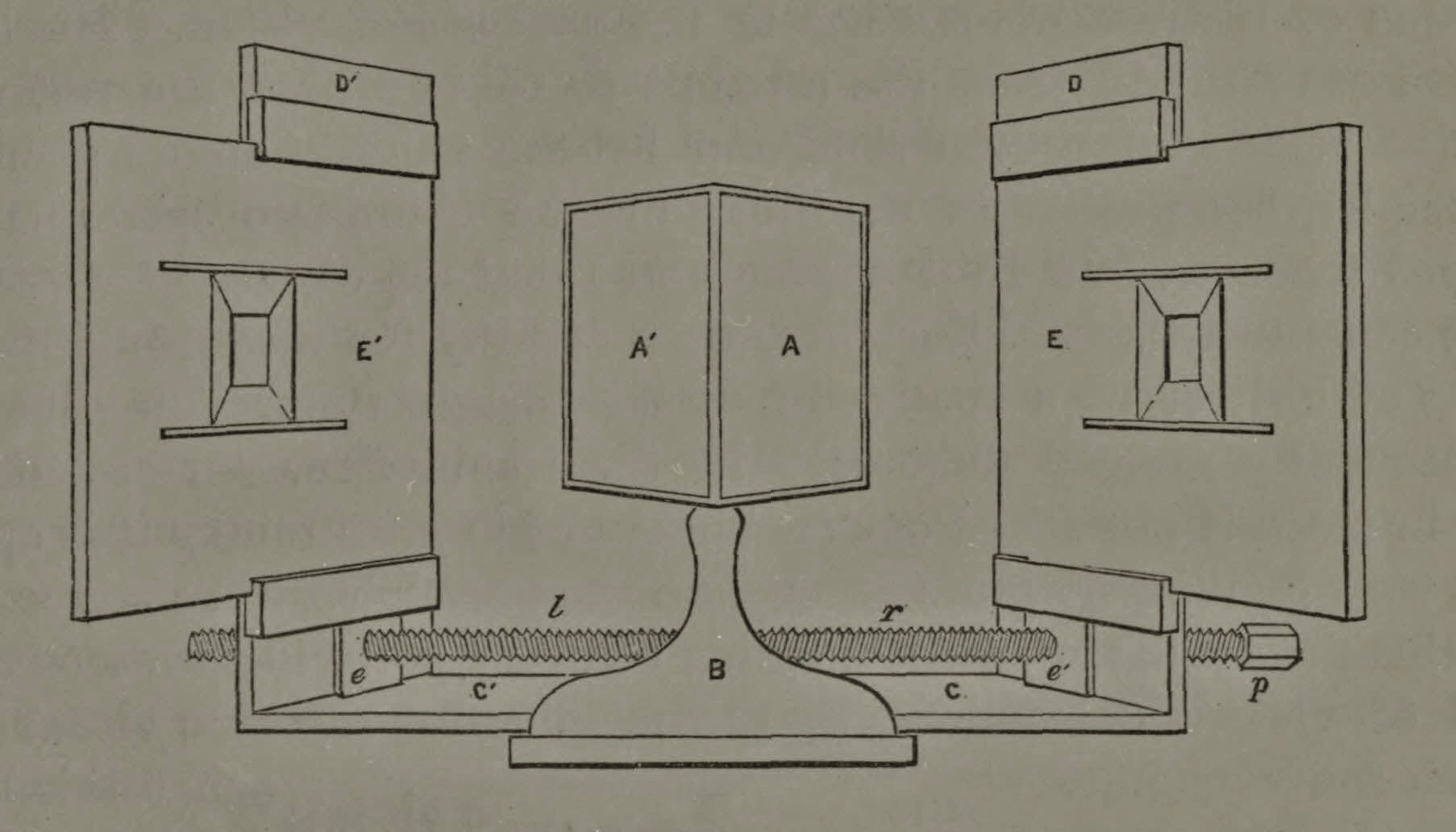 |
Figure 2 – Wheatstone's First Design |
When we look at an object, like the die in figure 1, we see a single image. How do such dissimilar images combine to become one coherent image (without flipping from side to side to show first the side with the 3 on in and then the side with the 1 on it)? Many thought that this was not possible, so Wheatstone designed the stereoscope to prove that it was.
He drew left and right-side images of different solids and placed the right-side image on the left image-plate* (E' in figure 2) and the left-side image on the right image-plate (E in figure 2). He looked into the mirrors (A' and A) and saw the result which was amazing! Not only did they cohere as one but the object looked more powerfully 3D than any other depiction of an object that he had ever seen.
He built the stereoscope also to try out other means by which we perceive depth and volume, such as the size of the picture on the retina. A large image is probably of something closer to us; and if that image gets smaller we can assume that the thing is moving away from us (e.g. as we watch a car speeding away from us down the highway). He varied the size of his images by having the image-plates move closer to or further away from the mirrors. The wooden screw with left and right-hand threads (l, r in figure 2) synchronizes the motion of the two plates.
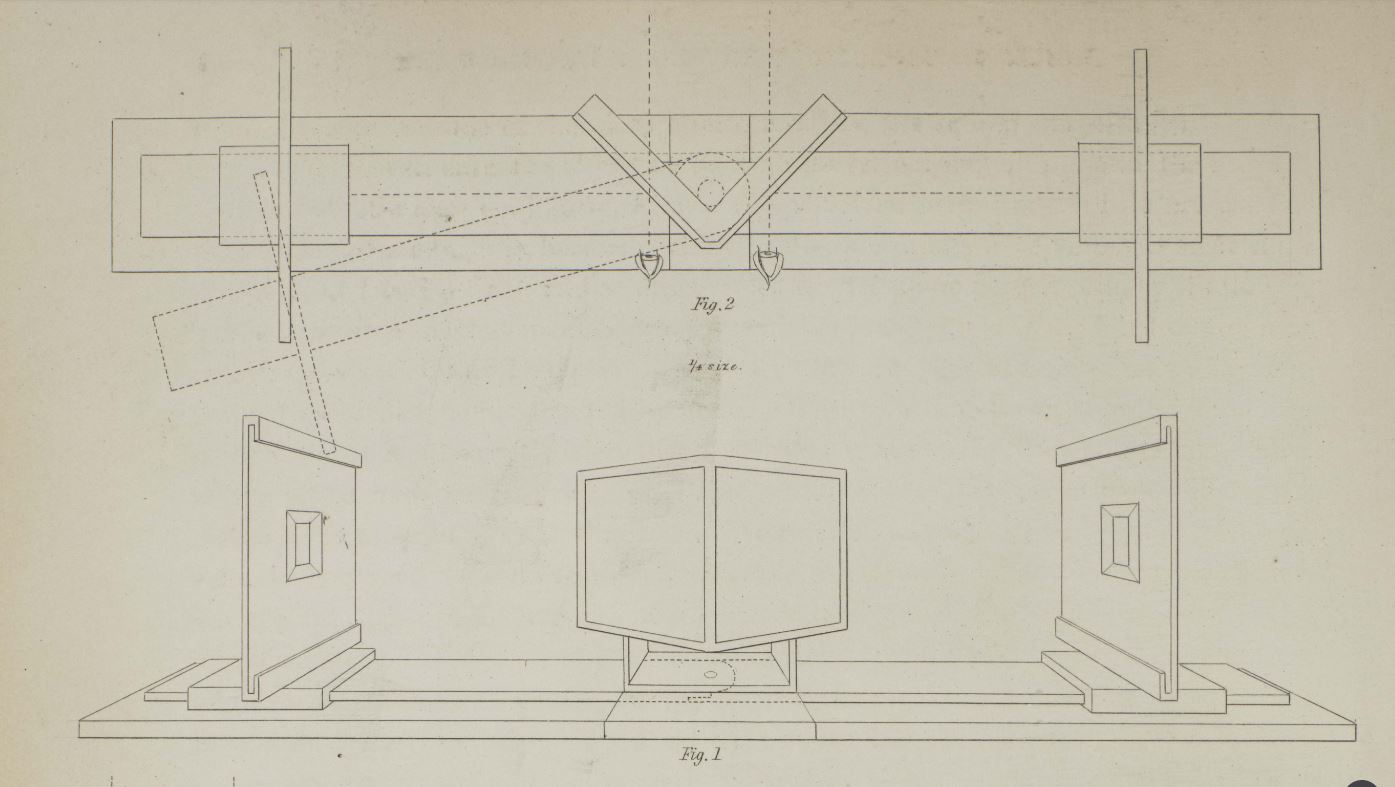 |
Figure 3 – Wheatstone's Pivoting Design |
Wheatstone built another version of the stereoscope that helped him think about the role of the angle of convergence of the two eyes in our perception of space and volume. We call this binocular convergence.
René Descartes and philosophers throughout the 18th century believed that binocular convergence gave us precise measurements of how far things were from our eyes. They thought it was one of our most powerful means of perceiving space.
Note how the two arms of this stereoscope (figure 3) are able to pivot. The image-plates can move along the arms closer to or further from the eyes, but not in a synchronized way.
As you can see, my first replica (figure 4), built in 2015, was a simple version of Wheatstone's pivoting design (figure 3). Wheastone's rests on a large table. I didn't have the dedicated space for that. Also I made mine convertable into a telestereoscope and wanted to be able to carry it to different locations, so I designed it to sit on top of a tripod.
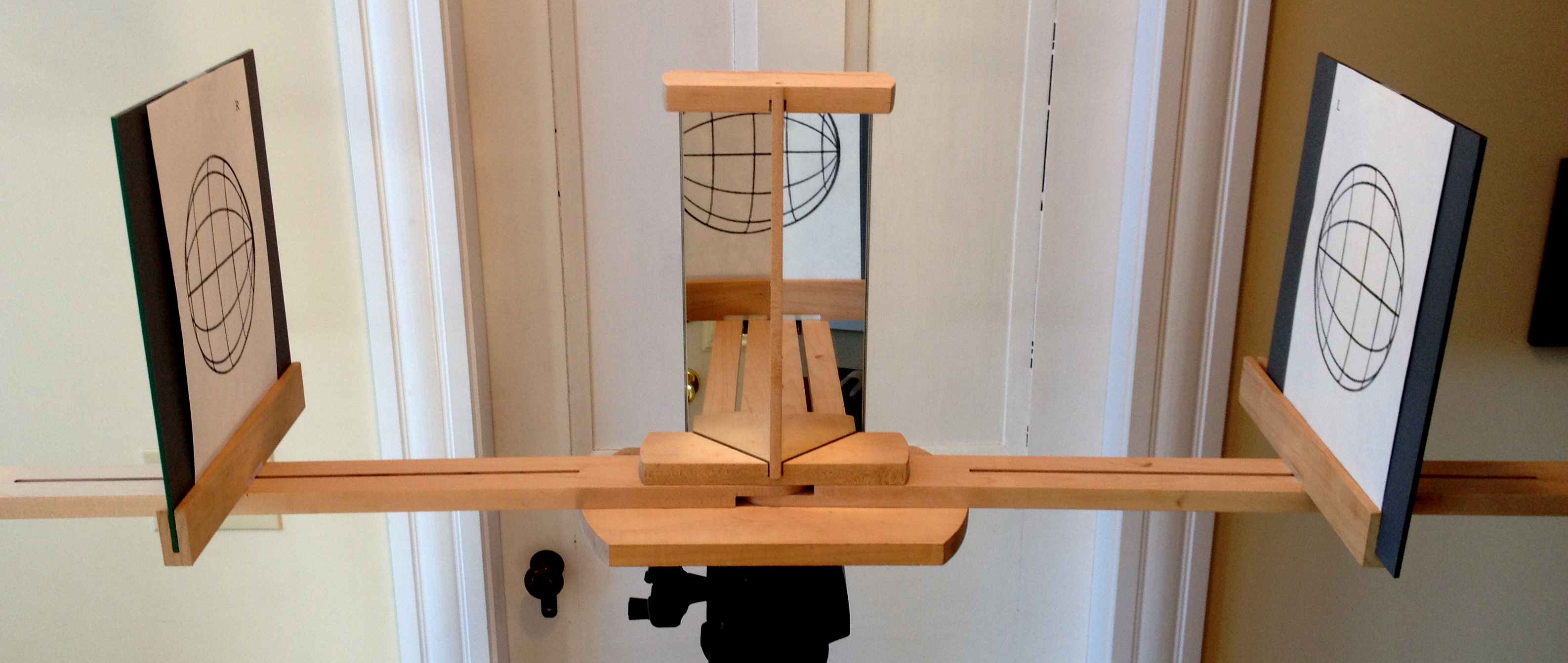 |
Figure 4 – My First Replica |
I learned a lot from my first stereoscope about the 19th-century scientific debates that Wheatstone's work excited, as well as about the principles of 3D vision. The diagrams and animations that I made to illustrate what was going on are based on this stereoscope (figure 4).
The device was supposed to help Wheatstone see what we see in binocular vision. But the way that it abstracted vision from the everyday taken-for-granted way we see the world rendered him, and many others in the 19th century, uncertain about what they see when they see. That is the most interesting lesson it teaches.
These are some of the other things the device showed me that it would have been difficult to learn only by reading and thinking:
Building and designing is a dialectical process. Initial ideas take material form. When you interact with the thing you have built you better understand its workings and its flaws. New ideas emerge for how to do it better.
 |
Figure 5 – Gears to Pivot Arms |
I began thinking of how to make the device more precise, more beautiful and more multi-functional. First, I wanted to see if I could combine both the motion of the image-plates and the pivoting of the arms in the same device. Wheatstone's screw (figure 2) was a rigid element that prevented the arms from pivoting.
Figure 6 – Scale and Wires |
Wheatstone's pivot was also not synchronized – an effect that I thought could be achieved with wooden gears (figure 5). The placement of the gears meant that the pivots had to be pushed aside. That provided an opportunity to locate each pivot in front its respective eye. In this way the angle of the eye could become more closely matched by the angle of the arm.
I also made scales on the base of the stereoscope that measure the position of the arms. One, like a protractor, measures it in degrees (figure 5); the other (figure 6) calculates the apparent distance that the imaged object should appear according to the "trigonometry of the eye." To my eye, the calculated distances bear no relation to the perceived distances, which suggests that there is a problem with the 18th-century theory.
The second major problem was how to synchronize the movement of the image-plates now that the arms pivoted. The solution I devised is a bit like the mechanisms that moved stage-flats in eighteenth-century theatres. There is a block that slides in a channel in the arm (figure 6). That is attached to a wire that runs around a hidden pulley at end of the arm back through the block and from there through the centre of the stereoscope and out the other arm where it attaches to the block of the second image-plate. There are two such wires connected in a continuous loop with a crossover in the centre. The two image-plates are in this way attached so that if you push the right plate left towards the mirrors, the left plate will follow, moving right toward the mirrors.
The wires have to run through the gears. So I made a half-channel for them to run through (figure 5). Pivoting the arms would increase the length of the wire loop, so I added springs that allow for expansion (figure 6) and have the added benefit of smoothing the motion.
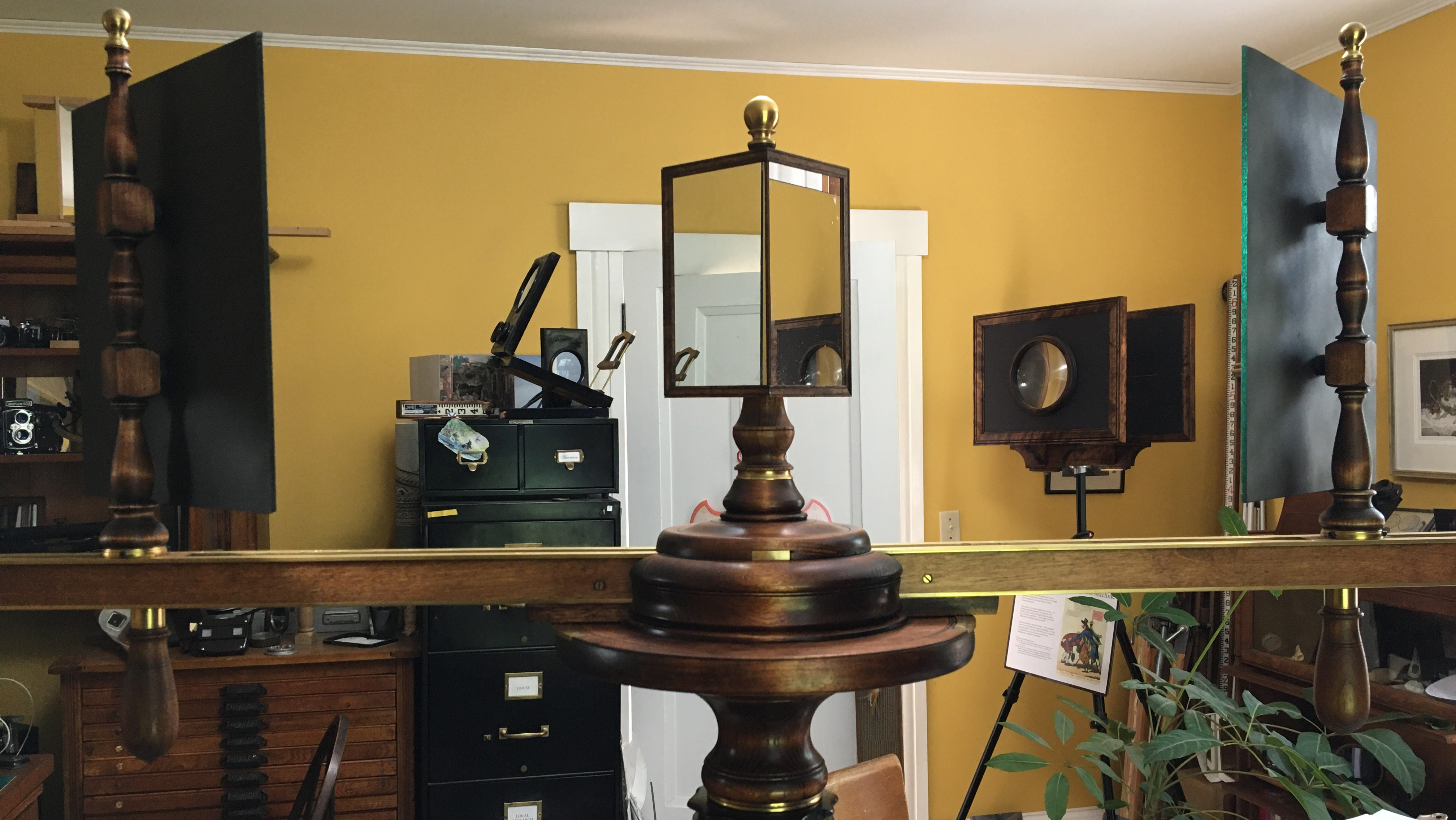 |
Figure 7 – Telestereoscope |
I wanted this device to be, like my first replica, convertible into a telestereoscope which allows you to see a "hyperstereo" world – that is, it allows you to see the world as though your eyes were up to 3 feet apart instead of the normal 2 1/2 inches.
Figure 8 – Convertible Base |
For this use, the image-plates must be replaced with mirrors. A system of magnets was the best way I could devise of affixing both the plates and the mirrors that was light and simple. I wanted to avoid heavy and cumbersome frames for the mirrors.
The mirrors pivot 45 degrees away from the viewer to direct the eyes forward. To enable this motion I made a captive inner sleeve and outer ring in brass at the base of each support post (figure 8). Three allen screws register it at a 45 degree rotation and secure it in place.
The handles beneath each support post (figure 7) can be used to widen or lessen the distance between your "mirror-eyes."
Figure 9 – Disassembled |
A challenging constraint for the design of this and most of my other optical devices, was that it had to be able to be easily disassembled (figure 9) and packaged (figure 10) so that I could take it in my luggage when I flew to Europe. There is more interest in Europe for the kinds of workshops that I do.
Figure 10 – Rifle Case |
Quick assembly-disassembly ideas like the magnets to attach mirrors, or finials that function as bolts that can be unscrewed by hand, make the process of setting up for workshops and taking them down much easier.
The best container for the Wheatstone stereoscope, given its length, was a rifle case (figure 10). American border guards liked it, as it made them want to talk about guns. Portuguese border guards thought it was very suspicious.